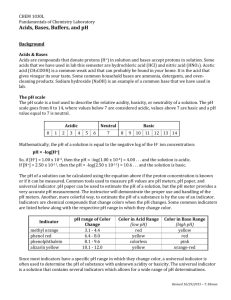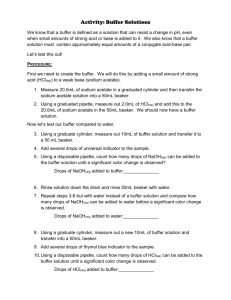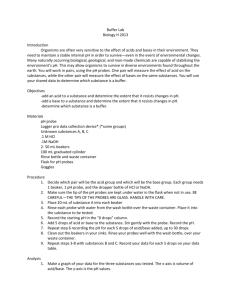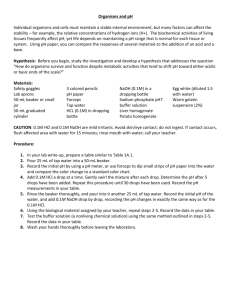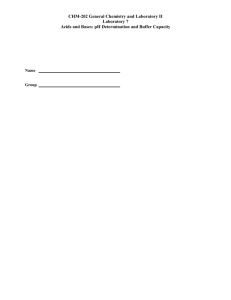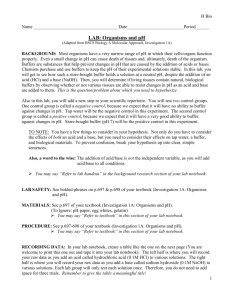Buffers lab
advertisement
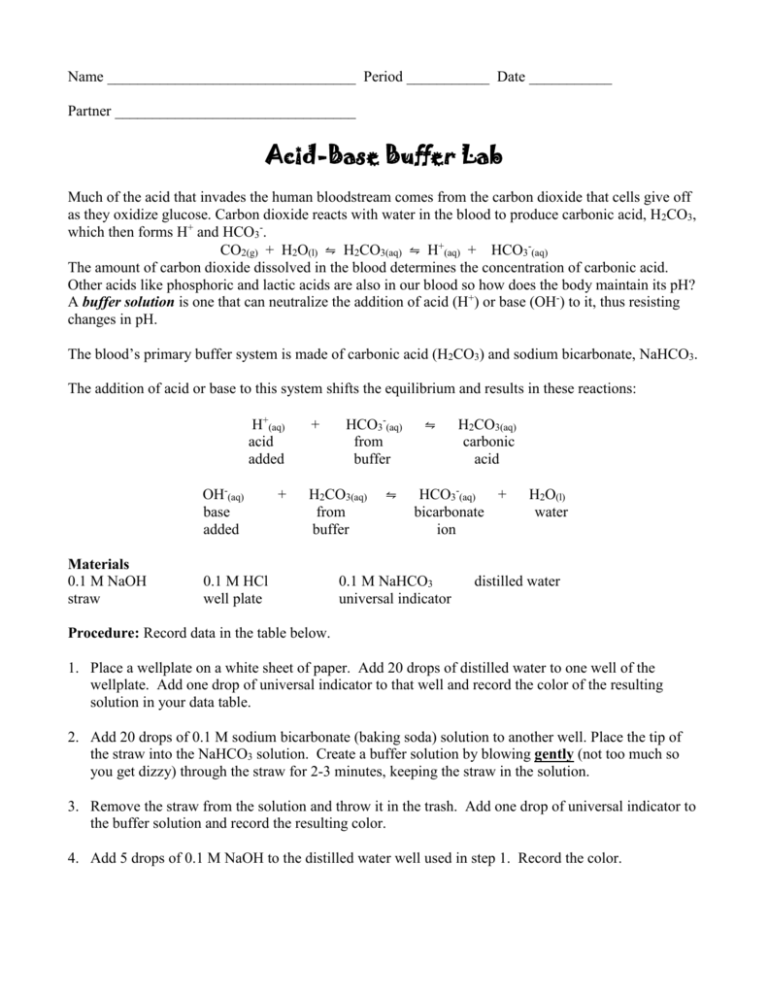
Name _________________________________ Period ___________ Date ___________ Partner ________________________________ Acid-Base Buffer Lab Much of the acid that invades the human bloodstream comes from the carbon dioxide that cells give off as they oxidize glucose. Carbon dioxide reacts with water in the blood to produce carbonic acid, H2CO3, which then forms H+ and HCO3-. CO2(g) + H2O(l) ⇋ H2CO3(aq) ⇋ H+(aq) + HCO3-(aq) The amount of carbon dioxide dissolved in the blood determines the concentration of carbonic acid. Other acids like phosphoric and lactic acids are also in our blood so how does the body maintain its pH? A buffer solution is one that can neutralize the addition of acid (H+) or base (OH-) to it, thus resisting changes in pH. The blood’s primary buffer system is made of carbonic acid (H2CO3) and sodium bicarbonate, NaHCO3. The addition of acid or base to this system shifts the equilibrium and results in these reactions: H+(aq) acid added OH-(aq) base added Materials 0.1 M NaOH straw + + HCO3-(aq) from buffer H2CO3(aq) from buffer 0.1 M HCl well plate ⇋ ⇋ H2CO3(aq) carbonic acid HCO3-(aq) + bicarbonate ion 0.1 M NaHCO3 universal indicator H2O(l) water distilled water Procedure: Record data in the table below. 1. Place a wellplate on a white sheet of paper. Add 20 drops of distilled water to one well of the wellplate. Add one drop of universal indicator to that well and record the color of the resulting solution in your data table. 2. Add 20 drops of 0.1 M sodium bicarbonate (baking soda) solution to another well. Place the tip of the straw into the NaHCO3 solution. Create a buffer solution by blowing gently (not too much so you get dizzy) through the straw for 2-3 minutes, keeping the straw in the solution. 3. Remove the straw from the solution and throw it in the trash. Add one drop of universal indicator to the buffer solution and record the resulting color. 4. Add 5 drops of 0.1 M NaOH to the distilled water well used in step 1. Record the color. 5. Counting the number of drops, add 0.1 M NaOH dropwise to the well containing the buffer solution and universal indicator until its color matches the color (not the intensity) in the well from Step 4. Record the number of drops required. 6. Repeat steps 1, 2 & 3 using clean, dry wells. No need to record data again. 7. Add 5 drops of 0.1 M HCl to the new well containing distilled water and universal indicator. Record the color. 8. Counting the number of drops, add 0.1 M HCl drop-wise to the well containing the buffer solution and universal indicator until its color matches the color in the well from Step 7. Record the number of drops required. 9. Dispose of the solutions in the sink. Wash the wellplate. 10. Wash your hands thoroughly. Step # Starting Material 1 Distilled water 3 Buffer Solution Distilled water + Universal Indicator Buffer Solution + Universal Indicator Distilled water + Universal Indicator Buffer Solution + Universal Indicator 4 5 7 8 Data Table Added Color Universal Indicator Universal Indicator 0.1 M NaOH Approx. pH # of Drops 5 drops added 0.1 M NaOH 0.1 M HCl 5 drops added 0.1 M HCl Questions: 1. Did your bicarbonate buffer solution perform as a buffer? ________ What observations support your answer? __________________________________________________________________ _____________________________________________________________________________ 2. Compare the number of drops of base needed to change the water and the buffer to the same pH. _____________________________________________________________________________ Compare the number of drops of acid needed to change the water and the buffer to the same pH. _____________________________________________________________________________ 3. Write an equation showing how bicarbonate ions (HCO3-) would prevent the pH of the blood from rising if a small quantity of base (OH-) were added. Name _________________________________ Period _________ Date ________________ Buffers Pre-Lab Questions 1. If you held your breath, how would this affect the [CO2] in the blood? _____ increase [CO2] or _______ decrease [CO2] The pH of the blood? _____ increase pH or _______ decrease pH. 2. Hyperventilation is a condition of forced heavy breathing that typically occurs when an individual is frightened or near physical exhaustion. How would hyperventilation affect the [CO2] in the blood? _____ increase [CO2] or _______ decrease [CO2]. How would this affect the pH of the blood? _____ increase pH or _______ decrease pH. One first aid treatment to get blood back to the proper pH is to have the person breathe into a paper bag for a short time. Comment on how this treatment works chemically to re-establish blood pH. ______________________________________________________________________________ ______________________________________________________________________________ 3. Strenuous muscle activity, such as long distance running, can cause lactic acid to accumulate in the blood, resulting in a wobbly feeling in leg muscles. How would the accumulation of lactic acid affect blood pH? _____ increase pH or _______ decrease pH. What condition of acid-base imbalance might be caused by a large overdose of aspirin (acetylsalicylic acid)? 4. Cardiac arrest occurs when the heart stops beating, blood circulation is halted and breathing stops, but cellular respiration (production of CO2 by the body) continues. When this occurs, doctors sometimes inject NaHCO3(aq) directly into the heart muscle, even before trying to restart the heart. What affect would cardiac arrest have on blood pH? _____ increase pH or _______ decrease pH. Show the equilibrium equation that proves your answer. How would the injection counteract this affect? ____________________________________________________________________________ ____________________________________________________________________________ ____________________________________________________________________________

